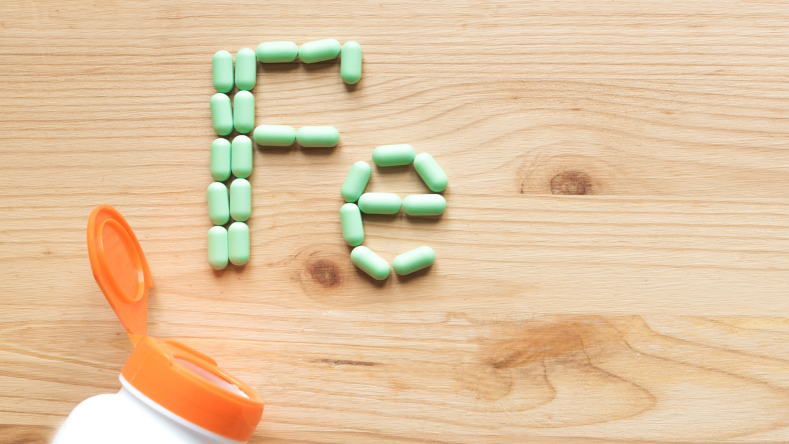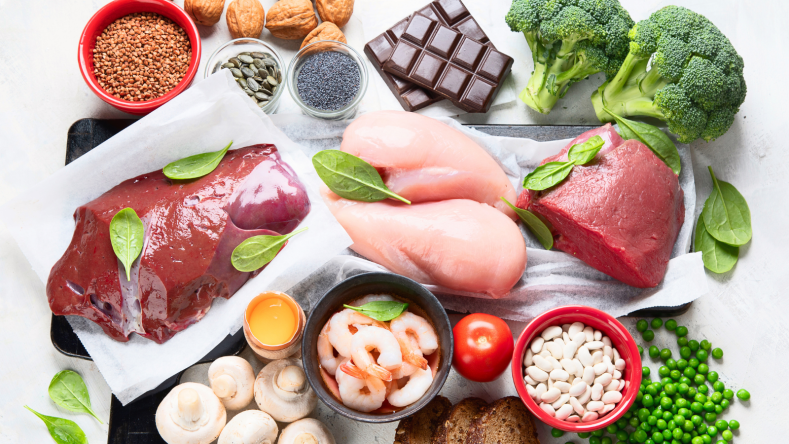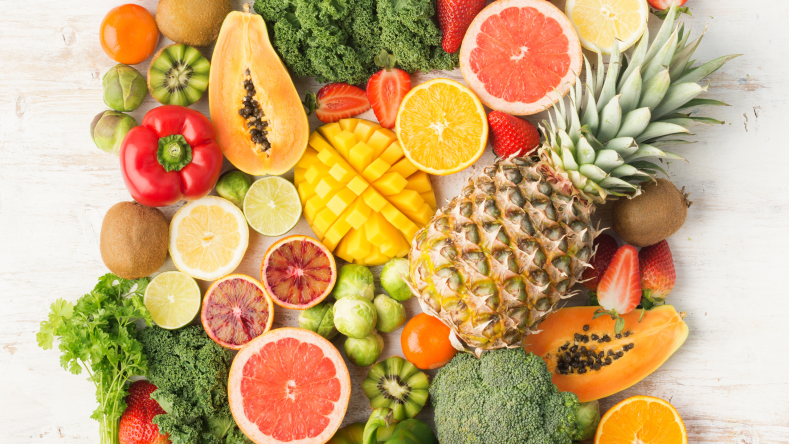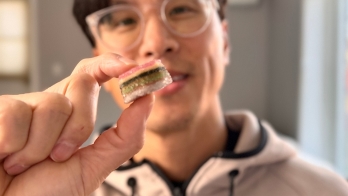The ultimate guide to iron
Iron is an essential mineral that plays many critical roles in the body, yet certain populations might be at a higher risk for deficiency. Here’s what science has to say about the importance of iron, ferritin, and subsequent supplementation.

If you’re feeling sluggish, fatigued, and foggy, you may want to consider your iron status. This mineral is essential for many aspects of your health, but it can come with a few contraindications if you take it incorrectly.
From supplements to side effects, here’s everything you need to know about iron and why you may want to pay attention to your stored iron (ferritin) levels.
What is iron?
Iron is a mineral that is essential for healthy red blood cells, which transport oxygen throughout your body [ 1 2 3
What is ferritin?
Ferritin is a blood protein that contains iron and is an indicator of current iron stores.
Low levels of ferritin may reflect low iron intake and be used as an indicator of iron deficiency and sometimes anemia. Conversely, high ferritin levels can be caused by hemochromatosis (a genetic condition), as well as obesity, inflammation, rheumatoid arthritis, type 2 diabetes, and liver disease [ 39 40
You can check your levels with a ferritin test.
Ferritin and copper
Notable research suggests that low ferritin doesn’t always correlate with low iron levels, though–copper may also be to blame.
Copper is a mineral that helps attach iron to hemoglobin and loads ferritin with iron [ 6 7
When copper levels are low, there is less ceruloplasmin available, which means the body may absorb less iron, which may then lead to an iron deficiency over time. As such, some experts suggest that iron deficiency may really be a copper deficiency in disguise, and should be treated as such [ 6
Copper levels could be low for a number of reasons, but the main culprit may be due to nutrient depletion in the soil, which in turn affects plants and animals. While certain foods are rich in copper (like shellfish, liver, fatty fish, oysters, spirulina, shiitake mushrooms, lobster, and dark chocolate), you may also want to discuss supplementation with your provider to help meet your needs.

How much iron per day?
The recommended dietary allowance (RDA) for iron varies greatly between men and women, as well as by age. The RDA for adults is as follows [ 1
Women 19 to 50 years old: 18 mg
Women 51 years old and above: 8 mg
Pregnant and lactating women: 27 mg and 9 mg, respectively
Men and non-menstruating women: 8 mg
Vegetarians: 1.8 times the RDA to compensate for reduced iron bioavailability and absorption [
8
].
However, your personal needs may differ, especially if you have a condition that impairs iron absorption (like celiac disease or Crohn’s disease), or hemochromatosis. [ 9
Talk with your healthcare provider to determine how much iron is right for you.
What does low iron saturation mean?
Iron saturation measures the amount of iron that is present in the blood. Therefore, low iron saturation means that there is a low amount of iron in the blood, which may mean an iron deficiency.
There are a few ways to measure iron saturation levels [ 4
Total iron-binding capacity (TIBC). TIBC is a test that can indicate the saturation level of iron. The normal range for TIBC is 250–450 mcg/dl, so a value higher than this range may indicate iron deficiency or low iron saturation.
Transferrin. Transferrin saturation is calculated as the ratio of iron to transferrin or iron to total iron-binding capacity, and may indicate the level of iron saturation in the blood [
5
]. The normal range for transferrin is 204–360 mg/dL, so any amount higher than this indicates a low level of iron saturation.Serum iron test. This test measures the level of iron in the blood. The normal range for serum iron is 65–175 mcg/dl for males, 50–170 mcg/dl for females, and 50–120 mcg/dl for children. Values below these reference ranges also indicate a low iron saturation.
What are normal ferritin levels by age?
The normal ferritin levels by age are as follows [ 10
Adult males: 20 to 250 ng/mL
Females 18-39 years old: 10 to 120 ng/mL
Females over 40 years old: 12 to 263 ng/mL
Newborns: 25 to 200 ng/mL
1 month old: 200 to 600 ng/mL
2 to 5 months old: 50 to 200 ng/mL
Children 6 months to 15 years: 7 to 140 ng/mL
Since ferritin levels can vary so much between age groups and gender, it can be difficult to determine a dangerously low ferritin level. However, serum ferritin levels <10 to <35ng/mL generally correspond with iron depletion or deficiency [ 11
Low ferritin treatment
Low ferritin levels can also be treated with oral iron supplements, but intravenous iron may be used as a treatment in severe cases of anemia [ 34 35
Depending on the severity of low ferritin levels, it can take anywhere from three to six months with a daily dose of 100 - 200 mg/day of elemental iron to replenish your iron stores. Additionally, a multivitamin with 18 mg/iron per day can also be beneficial for mild to moderate iron deficiency [ 34 35
While it may take time to replenish iron stores, deficiency symptoms may ease within a week or month of supplementation.
Signs of iron deficiency
Research shows that 15-35% of female athletes, 3-11% of male athletes, and over 20% of women of reproductive age are deficient in iron [ 29 30 1 31
Infants and young children
Women with heavy menstrual bleeding
Vegetarians
Endurance athletes
Frequent blood donors
People with cancer, GI disorders, or heart failure
Some signs of iron deficiency include weakness, fatigue, gastrointestinal symptoms, impaired cognitive and immune function, poor temperature regulation, and anemia [ 1 32 33
Athletes who are iron deficient may experience chronic fatigue, elevated heart rate, low power rates, loss of endurance, poor appetite, recurring illness, and irritability, all of which can impact performance and well-being. [ 46
Anemia vs. iron deficiency anemia
Anemia is a condition that occurs when your blood has a lower amount of red blood cells than normal [ 42
While there are many different types of anemia, the most common one is iron-deficiency anemia, which occurs in tandem with low iron levels. One indicator of iron-deficiency anemia is excess hepcidin (a key regulator of iron stores), as high levels of hepcidin can block intestinal iron absorption and therefore cause anemia [ 43 44 45

Iron rich foods
You can find iron in a variety of food sources, though some foods are more bioavailable, and hence better absorbed, than others. Let’s turn to science to better understand this complex mineral.
Heme vs non heme iron
While there are many dietary sources of iron to turn to, not all are created equal. Here’s the difference between heme vs non heme iron.
Heme iron: This is the most bioavailable form of iron, as up to 40% of it is readily absorbed by your body [
12
]. Since it’s found in animal foods, good sources include beef, pork, chicken, veal, fish (such as halibut, haddock, perch, salmon or tuna), shellfish, and red meats [1
].Non heme iron: This form of iron comes from plant sources (such as spinach, broccoli, beans, and legumes) and iron-fortified foods. Unfortunately for vegetarians and vegans, the bioavailability from non heme iron sources varies between 5-12%, making it difficult to meet iron needs without adequate planning. Furthermore, several compounds found in grains, beans, and cereals can diminish the absorption of non heme iron even further [
1
].
Factors that influence iron absorption
Studies have found that certain foods can inhibit iron absorption:
Phytates. Foods like beans, seeds, nuts, grains, and legumes contain phytic acid, which can inhibit iron absorption [
13
,14
,15
].Calcium. Calcium has been found to inhibit iron absorption, so calcium-rich foods should not be consumed with meals that offer a large amount of iron [
16
].Polyphenols. Coffee and tea contain polyphenols (naturally occurring plant compounds that act as antioxidants), which can significantly reduce iron absorption [
17
,18
].
On the flip side, research indicates that you can improve iron absorption by pairing an iron-rich food with 100 mg of vitamin C, as it’s been found this may yield a 67% increase in iron absorption [ 19 20 21

Iron supplements
Another way to increase iron levels can be through iron supplements. Oral iron supplementation primarily works to restore low iron levels, but they should be taken with precaution and under a doctor’s supervision, as iron dosages may look different for everyone.
The most common iron supplements include [ 1 25 26
Ferrous sulfate
Ferrous gluconate
Ferric citrate
Ferric sulfate
Generally speaking, the ferrous iron form in supplements has a higher solubility, is more bioavailable, tends to be better tolerated, and is more cost-effective than ferric iron [ 27
How to take iron supplements for best absorption
Taking iron pills isn’t as easy as it may sound. Here’s how you can get the most out of your iron supplements.
Pair with vitamin C. It’s recommended to pair iron supplements with 200 mg of vitamin C (like an 8-ounce glass of orange juice) to increase absorption.
Avoid certain foods. You should avoid milk, yogurt and other high calcium foods, as well as caffeine and high-fiber foods for at least one hour before and after taking your iron supplement, as these can interfere with iron absorption. Additionally, wait at least one hour before taking antacids or calcium supplements [
1
].Follow the doctor’s orders. Take your iron supplement as prescribed by your doctor or dietitian since iron type and dosing can differ from person to person and may interact with certain medications.
While iron supplements may be beneficial for some, they might not be necessary for everyone. As such, it’s recommended to consume more iron-rich foods and cut out foods that hinder iron absorption to start increasing your iron levels.
Best time to take iron supplements
The best time to take iron supplements is on an empty stomach. However, you can take them with water or Vitamin C rich fruit juice to make them easier to swallow [ 22
Some people may experience stomach cramps, nausea, and diarrhea when taking iron supplements, so if this is the case, you may want to consider taking iron with a small amount of food [ 23
Do iron supplements interact with medications?
Iron supplements may interact with several medications including [ 23
Tetracycline
Penicillin
Ciprofloxacin
Drugs used to for thyroid conditions
Drugs used for Parkinson's disease and seizures
Medicines that reduce stomach acid
Speak with your healthcare provider before embarking on a supplement routine.
Iron supplement side effects
The side effects from taking iron supplements can range in severity. Some common side effects include constipation, diarrhea, nausea, vomiting, seizures, rapid heartbeat, or stomach cramps [ 23 24
If you experience any side effects, stop taking your iron supplements and talk with your healthcare provider immediately.
Can you consume too much iron?
Though iron is an essential mineral, it can be toxic to the body in high amounts. Excess iron intake (>45 mg/day) can lead to iron toxicity, elevated ferritin levels, a damaged GI system and may result in negative side effects like nausea, vomiting, diarrhea and stomach pain. It can also accumulate in your organs over time and cause fatal damage to the liver or brain [ 28 41

How to increase ferritin levels
If you’re looking for ways to boost your iron levels, we’ve got you covered. Here are some science-backed ways to naturally increase ferritin levels.
Eat more lean meat. Research has shown that eating lean meat once per day can increase ferritin levels, so if you choose to eat meat, it’s encouraged to eat a variety of red and lean meats [
36
].Iron + vitamin C. Since vitamin C increases the absorption of non heme iron, try to consume both of them together during meals. For example, some lemon juice drizzled over leafy greens will increase the iron amount you absorb.
Soak, sprout, and ferment. Soaking, sprouting, and fermenting grains and legumes improve iron absorption by lowering the amount of phytates (an iron inhibitor) naturally present in these foods [
37
].Cooking in a cast-iron pan. Research shows that using cast-iron cookware may increase the iron content in your food by up to 16% [
38
].Consume copper-rich foods. You can increase your ferritin levels by consuming more copper-rich foods, like shellfish, liver, fatty fish, oysters, spirulina, shiitake mushrooms, lobster, and dark chocolate.
Avoid coffee, tea or milk near meals: Avoid caffeinated beverages or milk while eating iron-rich meals, and have them between eating times instead.
Summary
Iron is essential for healthy red blood cells and has been positively correlated with neurological development, cellular function, and improved mental, physical, and athletic performance.
You can obtain this mineral through iron-rich foods, as well as supplements, but since certain nutrients can impair absorption, it’s important to make sure you understand how best to take them. By pairing iron with vitamin C or avoiding calcium with high-iron meals, you can improve iron absorption and get the most out of this mineral.
Due to the complexity of iron, if supplementing, you should consult with a healthcare professional to determine your optimal dose and avoid any unpleasant side effects.
Disclaimer: The text, images, videos, and other media on this page are provided for informational purposes only and are not intended to treat, diagnose or replace personalized medical care.
Key takeaways
Iron is essential for healthy red blood cells, and has been positively correlated with neurological development, cellular function, and improved mental, physical, and athletic performance.
Research shows that 15-35% of female athletes, 3-11% of male athletes, and over 20% of women of reproductive age are deficient in iron [
29
,30
].Low copper levels may be an indication of low ferritin levels [
6
].Elevated ferritin levels can be caused by hemochromatosis (a genetic condition), as well as obesity, inflammation, rheumatoid arthritis, type 2 diabetes, and liver disease [
39
,40
].Vitamin C increases the absorption of non heme iron, whereas foods containing phytates, calcium, and polyphenols can inhibit iron absorption.
While iron supplements may be beneficial for some, supplementation might not be necessary for everyone. Talk with your healthcare provider to determine what course of action is right for you.
References
U.S. Department of Health and Human Services. (n.d.). Office of dietary supplements - iron. NIH Office of Dietary Supplements. Retrieved August 4, 2022, from
https://ods.od.nih.gov/factsheets/iron-healthprofessional/
U.S. National Library of Medicine. (n.d.). Pregnancy and birth: Do all pregnant women need to take iron supplements? National Center for Biotechnology Information. Retrieved August 4, 2022, from
https://www.ncbi.nlm.nih.gov/books
�UCSF Health. (2022, June 24). Hemoglobin and functions of Iron. ucsfhealth.org. Retrieved August 4, 2022, from
https://www.ucsfhealth.org/education/hemoglobin-and-functions-of-iron
Transferrin. Transferrin - Health Encyclopedia - University of Rochester Medical Center. (n.d.). Retrieved August 4, 2022, from
https://www.urmc.rochester.edu/encyclopedia/content.aspx?contenttypeid=167&contentid=transferrin
Pfeiffer, C. M., & Looker, A. C. (2017). Laboratory methodologies for indicators of iron status: strengths, limitations, and analytical challenges. The American journal of clinical nutrition, 106(Suppl 6), 1606S–1614S.
https://doi.org/10.3945/ajcn.117.155887
Collins, J. F., Prohaska, J. R., & Knutson, M. D. (2010). Metabolic crossroads of iron and copper. Nutrition reviews, 68(3), 133–147.
https://doi.org/10.1111/j.1753-4887.2010.00271.x
Copper blood level. Copper Blood Level - an overview | ScienceDirect Topics. (n.d.). Retrieved August 4, 2022, from
https://www.sciencedirect.com/topics/biochemistry-genetics-and-molecular-biology/copper-blood-level
Hunt J. R. (2003). Bioavailability of iron, zinc, and other trace minerals from vegetarian diets. The American journal of clinical nutrition, 78(3 Suppl), 633S–639S.
https://doi.org/10.1093/ajcn/78.3.633S
Saboor, M., Zehra, A., Qamar, K., & Moinuddin (2015). Disorders associated with malabsorption of iron: A critical review. Pakistan journal of medical sciences, 31(6), 1549–1553.
https://doi.org/10.12669/pjms.316.8125
Ferritin (blood). Ferritin (Blood) - Health Encyclopedia - University of Rochester Medical Center. (n.d.). Retrieved August 4, 2022, from
https://www.urmc.rochester.edu/encyclopedia/content.aspx?contenttypeid=167&contentid=ferritin_blood
Thomas, D. T., Erdman, K. A., & Burke, L. M. (2016). Position of the Academy of Nutrition and Dietetics, dietitians of Canada, and the American College of Sports Medicine: Nutrition and Athletic Performance. Journal of the Academy of Nutrition and Dietetics, 116(3), 501–528.
https://doi.org/10.1016/j.jand.2015.12.006
Hurrell, R., & Egli, I. (2010). Iron bioavailability and dietary reference values. The American journal of clinical nutrition, 91(5), 1461S–1467S.
https://doi.org/10.3945/ajcn.2010.28674F
Adams, S., Sello, C., Qin, G.-X., Che, D., & Han, R. (2018). Does dietary fiber affect the levels of nutritional components after feed formulation? Fibers, 6(2), 29.
https://doi.org/10.3390/fib6020029
Pramitha, J. L., Rana, S., Aggarwal, P. R., Ravikesavan, R., Joel, A. J., & Muthamilarasan, M. (2021). Diverse role of phytic acid in plants and approaches to develop low-phytate grains to enhance bioavailability of micronutrients. Advances in genetics, 107, 89–120.
https://doi.org/10.1016/bs.adgen.2020.11.003
Zijp, I. M., Korver, O., & Tijburg, L. B. (2000). Effect of tea and other dietary factors on iron absorption. Critical reviews in food science and nutrition, 40(5), 371–398.
https://doi.org/10.1080/10408690091189194
Lönnerdal B. (2010). Calcium and iron absorption--mechanisms and public health relevance. International journal for vitamin and nutrition research. Internationale Zeitschrift fur Vitamin- und Ernahrungsforschung. Journal international de vitaminologie et de nutrition, 80(4-5), 293–299.
https://doi.org/10.1024/0300-9831/a000036
Piskin, E., Cianciosi, D., Gulec, S., Tomas, M., & Capanoglu, E. (2022). Iron Absorption: Factors, Limitations, and Improvement Methods. ACS omega, 7(24), 20441–20456.
https://doi.org/10.1021/acsomega.2c01833
Are Anti-Nutrients Harmful? Hsph.harvard.edu. (n.d.). Retrieved August 4, 2022, from
https://www.hsph.harvard.edu/nutritionsource/anti-nutrients/
Hurrell, R., & Egli, I. (2010). Iron bioavailability and dietary reference values. The American journal of clinical nutrition, 91(5), 1461S–1467S.
https://doi.org/10.3945/ajcn.2010.28674F
Hurrell, R., & Egli, I. (2010). Iron bioavailability and dietary reference values. The American Journal of Clinical Nutrition, 91(5).
https://doi.org/10.3945/ajcn.2010.28674f
Hallberg, L., & Hulthén, L. (2000). Prediction of dietary iron absorption: an algorithm for calculating absorption and bioavailability of dietary iron. The American journal of clinical nutrition, 71(5), 1147–1160.
https://doi.org/10.1093/ajcn/71.5.1147
Mayo Foundation for Medical Education and Research. (2022, July 1). Iron Supplement (oral route, parenteral route) proper use. Mayo Clinic. Retrieved August 4, 2022, from
https://www.mayoclinic.org/drugs-supplements/iron-supplement-oral-route-parenteral-route/proper-use/drg-20070148
U.S. National Library of Medicine. (n.d.). Taking iron supplements: Medlineplus medical encyclopedia. MedlinePlus. Retrieved August 4, 2022, from
https://medlineplus.gov/ency/article/007478.htm
BSc, A. A. (2017, June 4). The dark side of iron - why too much is harmful. Healthline. Retrieved August 5, 2022, from
https://www.healthline.com/nutrition/why-too-much-iron-is-harmful
C;, C. (n.d.). Iron deficiency. Blood. Retrieved August 5, 2022, from
https://pubmed.ncbi.nlm.nih.gov/30401704/
Womack, R., Berru, F., Panwar, B., & Gutiérrez, O. M. (2020). Effect of Ferric Citrate versus Ferrous Sulfate on Iron and Phosphate Parameters in Patients with Iron Deficiency and CKD: A Randomized Trial. Clinical journal of the American Society of Nephrology : CJASN, 15(9), 1251–1258.
https://doi.org/10.2215/CJN.15291219
Chen, C. (2019). Enhancement of dietary content of iron in brassica oleracia through soil alterations. International Journal of High School Research, 1(2), 30–33.
https://doi.org/10.36838/v1i2.7
McDowell LA, Kudaravalli P, Sticco KL. Iron Overload. [Updated 2022 Apr 28]. In: StatPearls [Internet]. Treasure Island (FL): StatPearls Publishing; 2022 Jan-. Available from:
https://www.ncbi.nlm.nih.gov/books/NBK526131/
Collings, R., Harvey, L. J., Hooper, L., Hurst, R., Brown, T. J., Ansett, J., King, M., & Fairweather-Tait, S. J. (2013). The absorption of iron from whole diets: a systematic review. The American journal of clinical nutrition, 98(1), 65–81.
https://doi.org/10.3945/ajcn.112.050609
Sim, M., Garvican-Lewis, L. A., Cox, G. R., Govus, A., McKay, A. K., Stellingwerff, T., & Peeling, P. (2019). Iron Considerations for the athlete: A narrative review. European Journal of Applied Physiology, 119(7), 1463–1478.
https://doi.org/10.1007/s00421-019-04157-y
Camaschella, C. (2015). Iron-deficiency anemia. New England Journal of Medicine, 372(19), 1832–1843.
https://doi.org/10.1056/nejmra1401038
Agaoglu, L., Torun, O., Unuvar, E., Sefil, Y., & Demir, D. (2007). Effects of iron deficiency anemia on cognitive function in children. Arzneimittel-Forschung, 57(6A), 426–430.
https://doi.org/10.1055/s-0031-1296691
Jáuregui-Lobera I. (2014). Iron deficiency and cognitive functions. Neuropsychiatric disease and treatment, 10, 2087–2095.
https://doi.org/10.2147/NDT.S72491
U.S. Department of Health and Human Services. (n.d.). Anemia - iron-deficiency anemia. National Heart Lung and Blood Institute. Retrieved August 5, 2022, from
https://www.nhlbi.nih.gov/health/anemia/iron-deficiency-anemia
Iron supplements for anemia (ferrous sulfate): Types, benefits & side effects. Cleveland Clinic. (n.d.). Retrieved August 5, 2022, from
https://my.clevelandclinic.org/health/articles/14568-oral-iron-supplementation
Herran, O. F., Bermúdez, J. N., & Del Pilar Zea, M. (2020). Red meat and egg intake and serum ferritin concentrations in Colombian children: results of a population survey, ENSIN-2015. Journal of nutritional science, 9, e12.
https://doi.org/10.1017/jns.2020.5
Gupta, R. K., Gangoliya, S. S., & Singh, N. K. (2015). Reduction of phytic acid and enhancement of bioavailable micronutrients in food grains. Journal of food science and technology, 52(2), 676–684.
https://doi.org/10.1007/s13197-013-0978-y
Kulkarni, S. A., Ekbote, V. H., Sonawane, A., Jeyakumar, A., Chiplonkar, S. A., & Khadilkar, A. V. (2013). Beneficial effect of iron pot cooking on iron status. Indian journal of pediatrics, 80(12), 985–989.
https://doi.org/10.1007/s12098-013-1066-z
Adams P. (2008). Management of elevated serum ferritin levels. Gastroenterology & hepatology, 4(5), 333–334.
Pietrangelo A. (2010). Hereditary hemochromatosis: pathogenesis, diagnosis, and treatment. Gastroenterology, 139(2), 393–408.e4082.
https://doi.org/10.1053/j.gastro.2010.06.013
McDowell LA, Kudaravalli P, Sticco KL. Iron Overload. [Updated 2022 Apr 28]. In: StatPearls [Internet]. Treasure Island (FL): StatPearls Publishing; 2022 Jan-. Available from:
https://www.ncbi.nlm.nih.gov/books/NBK526131/
U.S. Department of Health and Human Services. (n.d.). Anemia - what is anemia? National Heart Lung and Blood Institute. Retrieved August 12, 2022, from
https://www.nhlbi.nih.gov/health/anemia
Nemeth, E., & Ganz, T. (2009). The role of hepcidin in iron metabolism. Acta haematologica, 122(2-3), 78–86.
https://doi.org/10.1159/000243791
Pagani, A., Nai, A., Silvestri, L., & Camaschella, C. (2019). Hepcidin and anemia: A tight relationship. Frontiers in Physiology, 10.
https://doi.org/10.3389/fphys.2019.01294
Pagani, A., Nai, A., Silvestri, L., & Camaschella, C. (2019). Hepcidin and Anemia: A Tight Relationship. Frontiers in physiology, 10, 1294.
https://doi.org/10.3389/fphys.2019.01294
Your guide to anemia - national institutes of health. (n.d.). Retrieved August 23, 2022, from https://www.nhlbi.nih.gov/files/docs/public/blood/anemia-inbrief_yg.pdf




